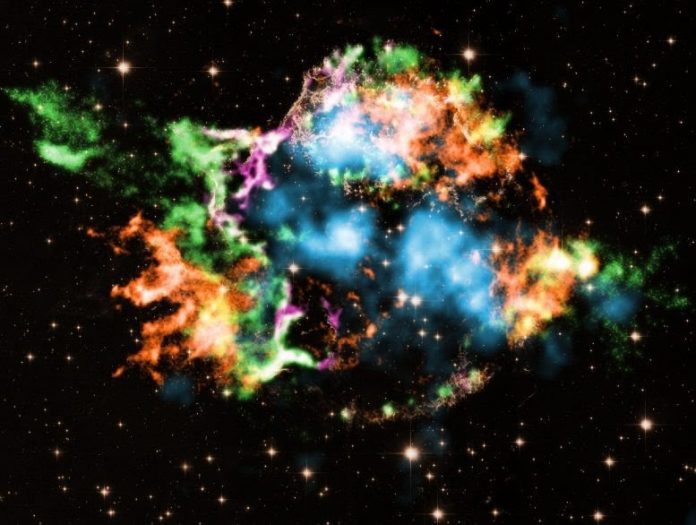[ad_1]
Stargazers utilizing NASA’s Chandra X-beam Observatory have declared the disclosure of a significant sort of titanium, alongside different components, impacting out from the focal point of the cosmic explosion remainder Cassiopeia A (Cas A). This new outcome could be a significant advance for seeing precisely how probably the most enormous stars detonate.
The various shadings in this new picture generally address components identified by Chandra in Cas A: iron (orange), oxygen (purple), and the measure of silicon contrasted with magnesium (green). Titanium (light blue) distinguished already by NASA’s NuSTAR telescope at higher X-beam energies is likewise appeared. These Chandra and NuSTAR X-beam information have been overlaid on an optical-light picture from the Hubble Space Telescope (yellow).
At the point when the atomic force wellspring of a monstrous star runs out, the middle implodes under gravity and structures either a thick heavenly center called a neutron star or, less frequently, a dark opening. At the point when a neutron star is made, within the falling monstrous star skips off the outside of the heavenly center, turning around the collapse.
The warmth from this calamitous occasion creates a stunning wave-like sonic blast from a supersonic stream — that races outwards through the remainder of the bound star, delivering new components by atomic responses as it goes. In any case, in numerous PC models of this cycle, energy is immediately lost and the stun wave’s excursion outwards slows down, forestalling the cosmic explosion blast.
Late three-dimensional PC recreations propose that neutrinos — exceptionally low mass subatomic particles — made in the production of the neutron star drive bubbles that dash away from the focal point of the blast. These air pockets keep driving the stunning wave forward to trigger the cosmic explosion blast.
This new Chandra study reports that finger-formed constructions pointing away from the blast site, to the lower right, contain titanium and chromium, corresponding with the iron flotsam and jetsam found in an orange. The titanium found by Chandra is a steady isotope of the component, implying that the quantity of neutrons its particles contain suggests that it doesn’t change by radioactivity into an alternate, lighter component. The titanium recently distinguished in Cas A with NuSTAR is a flimsy isotope, which changes over a timescale of around 60 years into scandium then calcium.
Related Article
Chat bubbles coming to Microsoft Teams next month!!!
Source link















